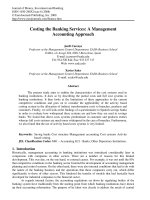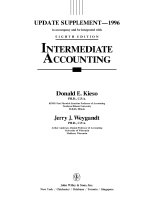Intermediate Accounting - Chap009 potx
Bạn đang xem bản rút gọn của tài liệu. Xem và tải ngay bản đầy đủ của tài liệu tại đây (718.14 KB, 57 trang )
Copyright © 2007 by The McGraw-Hill Companies, Inc. All rights reserved.
Inventories:
Additional
Issues
9
9-2
Learning Objective
Understand and apply the lower-of-cost-
or-market rule used to value inventories.
9-3
Lower of Cost or Market (LCM)
GAAP requires that inventories be
carried at cost or current market
value, whichever is lower.
GAAP requires that inventories be
carried at cost or current market
value, whichever is lower.
LCM is a departure from historical cost
LCM is a departure from historical cost
and is a conservative accounting
and is a conservative accounting
method.
method.
LCM is a departure from historical cost
LCM is a departure from historical cost
and is a conservative accounting
and is a conservative accounting
method.
method.
9-4
Determining Market Value
Net Realizable
Value (Ceiling)
Net Realizable Value
less Normal Profit
(Floor)
Market value is NOT
Market value is NOT
necessarily the
necessarily the
amount for which
amount for which
inventory can be
inventory can be
sold.
sold.
Accounting
Accounting
Research Bulletin
Research Bulletin
No. 43 defines
No. 43 defines
“market value” in
“market value” in
terms of current
terms of current
replacement cost.
replacement cost.
Market value is NOT
Market value is NOT
necessarily the
necessarily the
amount for which
amount for which
inventory can be
inventory can be
sold.
sold.
Accounting
Accounting
Research Bulletin
Research Bulletin
No. 43 defines
No. 43 defines
“market value” in
“market value” in
terms of current
terms of current
replacement cost.
replacement cost.
9-5
Determining Market Value
Net Realizable
Value (Ceiling)
Net Realizable Value
less Normal Profit
(Floor)
Net Realizable Value (NRV) is
the estimated selling price
less cost of completion and
disposal.
Net Realizable Value (NRV) is
the estimated selling price
less cost of completion and
disposal.
Replacement
Cost
Replacement
Cost
The definition of
The definition of
market
market
value
value
varies
varies
internationally. In many
internationally. In many
countries, for example
countries, for example
New Zealand market value
New Zealand market value
is defined as NRV.
is defined as NRV.
The definition of
The definition of
market
market
value
value
varies
varies
internationally. In many
internationally. In many
countries, for example
countries, for example
New Zealand market value
New Zealand market value
is defined as NRV.
is defined as NRV.
9-6
Determining Market Value
Net Realizable Value
less Normal Profit
(Floor)
Net Realizable
Value (Ceiling)
If replacement cost
> Ceiling, then
Ceiling = Market
Value
Replacement
Cost
Replacement
Cost
If replacement
cost < Floor, then
Floor = Market
Value
9-7
Lower of Cost or Market
An item in inventory is currently carried at
historical cost of $20 per unit. At year-end
we gather the following per unit
information:
current replacement cost = $21.50
current replacement cost = $21.50
selling price = $30
selling price = $30
cost to complete and dispose = $4
cost to complete and dispose = $4
normal profit margin of = $5
normal profit margin of = $5
How would we value this item in the
Balance Sheet?
9-8
Lower of Cost or Market
Net Realizable
Value (Ceiling)
Net Realizable
Value less Normal
Profit (Floor)
Replacement
Cost =$21.50
Replacement
Cost =$21.50
Which one do
we use?
9-9
Market value = $21.50
Market value = $21.50
Cost = $20.00
Cost = $20.00
Should the inventory be
Should the inventory be
recorded at cost or market?
recorded at cost or market?
Market value = $21.50
Market value = $21.50
Cost = $20.00
Cost = $20.00
Should the inventory be
Should the inventory be
recorded at cost or market?
recorded at cost or market?
Market value = $21.50
Market value = $21.50
Cost = $20.00
Cost = $20.00
Since Cost < Market, the LCM
Since Cost < Market, the LCM
rule would dictate that inventory
rule would dictate that inventory
be recorded at Cost.
be recorded at Cost.
Market value = $21.50
Market value = $21.50
Cost = $20.00
Cost = $20.00
Since Cost < Market, the LCM
Since Cost < Market, the LCM
rule would dictate that inventory
rule would dictate that inventory
be recorded at Cost.
be recorded at Cost.
Lower of Cost or Market
Net Realizable
Value (Ceiling)
Net Realizable
Value less Normal
Profit (Floor)
Replacement
Cost =$21.50
Replacement
Cost =$21.50
In this case, market value will
In this case, market value will
be $21.50 because the
be $21.50 because the
replacement cost is between the
replacement cost is between the
ceiling and the floor.
ceiling and the floor.
In this case, market value will
In this case, market value will
be $21.50 because the
be $21.50 because the
replacement cost is between the
replacement cost is between the
ceiling and the floor.
ceiling and the floor.
9-10
Lower of Cost or Market
An inventory item is currently carried at
An inventory item is currently carried at
historical cost of $95.00 per unit. At the
historical cost of $95.00 per unit. At the
Balance Sheet date we gather the
Balance Sheet date we gather the
following per unit information:
following per unit information:
current replacement cost = $80.00
current replacement cost = $80.00
NRV = $100.00
NRV = $100.00
NRV reduced by normal profit = $85.00
NRV reduced by normal profit = $85.00
How would we value the item on our
How would we value the item on our
Balance Sheet?
Balance Sheet?
An inventory item is currently carried at
An inventory item is currently carried at
historical cost of $95.00 per unit. At the
historical cost of $95.00 per unit. At the
Balance Sheet date we gather the
Balance Sheet date we gather the
following per unit information:
following per unit information:
current replacement cost = $80.00
current replacement cost = $80.00
NRV = $100.00
NRV = $100.00
NRV reduced by normal profit = $85.00
NRV reduced by normal profit = $85.00
How would we value the item on our
How would we value the item on our
Balance Sheet?
Balance Sheet?
9-11
Lower of Cost or Market
Net Realizable Value
less Normal Profit
(Floor) = $85
Net Realizable Value
(Ceiling) = $100
Replacement
Cost =$80
Replacement
Cost =$80
?
?
?
Which one do
we use as
market value?
Which one do
we use as
market value?
9-12
Lower of Cost or Market
Should the inventory be carried at
Market Value or Cost?
Should the inventory be carried at
Market Value or Cost?
Market = $85 < Cost = $95
Our inventory item will be written down
to the Market Value $85.
Market = $85 < Cost = $95
Our inventory item will be written down
to the Market Value $85.
Net Realizable Value
less Normal Profit
(Floor) = $85
Net Realizable Value
(Ceiling) = $100
Replacement
Cost =$80
Replacement
Cost =$80
9-13
1. Apply LCM to
1. Apply LCM to
each individual item
each individual item
in
in
inventory.
inventory.
1. Apply LCM to
1. Apply LCM to
each individual item
each individual item
in
in
inventory.
inventory.
2. Apply LCM to each
2. Apply LCM to each
class
class
of inventory.
of inventory.
2. Apply LCM to each
2. Apply LCM to each
class
class
of inventory.
of inventory.
3. Apply LCM to the
3. Apply LCM to the
entire
entire
inventory as a
inventory as a
group.
group.
3. Apply LCM to the
3. Apply LCM to the
entire
entire
inventory as a
inventory as a
group.
group.
Applying Lower of Cost or Market
Lower of cost or market can be applied 3
different ways.
9-14
Adjusting Cost to Market - Options
Record the Loss as a Separate Item in
the Income Statement
Adjust inventory directly or by using an
allowance account.
Record the Loss as part of Cost of
Good Sold
Adjust inventory directly or by using an
allowance account.
9-15
Learning Objective
Estimate ending inventory and cost of
goods sold using the gross profit method.
9-16
Inventory Estimation Techniques
Estimate instead of taking
physical inventory
Less costly
Less time consuming
Two popular methods are . . .
Gross Profit Method
Gross Profit Method
Retail Inventory Method
Retail Inventory Method
9-17
Gross Profit Method
Useful
when . . .
Useful
when . . .
Estimating inventory
& COGS for interim
reports.
Estimating inventory
& COGS for interim
reports.
Determining the
cost of inventory
lost, destroyed, or
stolen.
Determining the
cost of inventory
lost, destroyed, or
stolen.
Auditors are testing
the overall
reasonableness of
client inventories.
Auditors are testing
the overall
reasonableness of
client inventories.
Preparing budgets
and forecasts.
Preparing budgets
and forecasts.
NOTE: The Gross Profit Method is not acceptable
for use in annual financial statements.
NOTE: The Gross Profit Method is not acceptable
for use in annual financial statements.
9-18
Gross Profit Method
This method assumes that the historical
gross margin rate is reasonably
constant in the short run.
This method assumes that the historical
gross margin rate is reasonably
constant in the short run.
Cost of beginning
inventory.
Cost of beginning
inventory.
Net purchases for
the period.
Net purchases for
the period.
Historical gross
margin rate.
Historical gross
margin rate.
Net sales for the
period.
Net sales for the
period.
We need to
We need to
know . . .
know . . .
We need to
We need to
know . . .
know . . .
9-19
Steps to the Gross Profit Method
1.
1.
Estimate Historical Gross Margin %.
Estimate Historical Gross Margin %.
2.
2.
Sales x (1 - Estimated Gross Margin %) =
Sales x (1 - Estimated Gross Margin %) =
Estimated COGS
Estimated COGS
3.
3.
Beg. Inventory + Net Purchases = Cost of
Beg. Inventory + Net Purchases = Cost of
Goods Available for Sale (COGAS)
Goods Available for Sale (COGAS)
4.
4.
COGAS - Estimated COGS = Estimated
COGAS - Estimated COGS = Estimated
Cost of Ending Inventory
Cost of Ending Inventory
1.
1.
Estimate Historical Gross Margin %.
Estimate Historical Gross Margin %.
2.
2.
Sales x (1 - Estimated Gross Margin %) =
Sales x (1 - Estimated Gross Margin %) =
Estimated COGS
Estimated COGS
3.
3.
Beg. Inventory + Net Purchases = Cost of
Beg. Inventory + Net Purchases = Cost of
Goods Available for Sale (COGAS)
Goods Available for Sale (COGAS)
4.
4.
COGAS - Estimated COGS = Estimated
COGAS - Estimated COGS = Estimated
Cost of Ending Inventory
Cost of Ending Inventory
9-20
Gross Profit Method
Matrix, Inc. uses the gross profit method to
estimate end of month inventory. At the end
of May, the controller has the following data:
•
Net sales for May = $1,213,000
•
Net purchases for May = $728,300
•
Inventory at May 1 = $237,400
•
Gross margin = 43% of sales
Estimate Inventory at May 31.
Estimate Inventory at May 31.
Matrix, Inc. uses the gross profit method to
estimate end of month inventory. At the end
of May, the controller has the following data:
•
Net sales for May = $1,213,000
•
Net purchases for May = $728,300
•
Inventory at May 1 = $237,400
•
Gross margin = 43% of sales
Estimate Inventory at May 31.
Estimate Inventory at May 31.
9-21
Gross Profit Method
NOTE: The key to successfully applying this
method is a reliable Gross Margin Percentage.
NOTE: The key to successfully applying this
method is a reliable Gross Margin Percentage.
9-22
Learning Objective
Estimate ending inventory and cost of
goods sold using the retail inventory method,
9-23
Retail Inventory Method
This method was developed for retail
operations like department stores.
Uses both the retail value and cost of
items for sale to calculate a cost to
retail ratio.
Objective: Convert ending
Objective: Convert ending
inventory at retail to ending
inventory at retail to ending
inventory at cost.
inventory at cost.
Objective: Convert ending
Objective: Convert ending
inventory at retail to ending
inventory at retail to ending
inventory at cost.
inventory at cost.
9-24
Retail Inventory Method
We need to
know . . .
We need to
know . . .
Sales for the
period.
Sales for the
period.
Beginning
inventory at retail
and cost.
Beginning
inventory at retail
and cost.
Adjustments to the
original retail price.
Adjustments to the
original retail price.
Net purchases at
retail and cost.
Net purchases at
retail and cost.
9-25
Steps to the Retail Inventory Method
1.
1.
Determine cost and retail value of goods
Determine cost and retail value of goods
sold.
sold.
2.
2.
Calculate the cost-to-retail %.
Calculate the cost-to-retail %.
3.
3.
Retail value of goods available for sale -
Retail value of goods available for sale -
sales = ending inventory at retail.
sales = ending inventory at retail.
4.
4.
Cost-to-retail % x Ending inventory at
Cost-to-retail % x Ending inventory at
retail = Estimated ending inventory at
retail = Estimated ending inventory at
cost.
cost.









